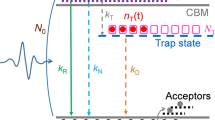Summary
Thermoreflectance (TR) measurements have extended to the far ultraviolet the high-resolution modulation techniques well established at lower energies. The TR spectrum of gold showed for the first time several new features up to 36 eV. Their interpretation is reanalysed also in view of recent CIS photoemission measurements. The TR spectra of the Rb+4p core excitons in Rb halides allowed us to resolve at 200 K some structures previously observed only at 8 K, enabling us to determine their temperature dependence. The exciton-phonon interaction is suggested to be responsible for the partial failure of the ligand field model for core excitons. The ionization continuum threshold of the Rb+4p states is also determined. Finally, TR experiments allowed us to discriminate between different interpretations suggested for the strong electron energy loss peak at the end of the valence band excitations of alkali halides.
Riassunto
L’alta risoluzione ottenuta mediante la spettroscopia modulatoria nella regione spettrale di più basse energie è stata estesa al lontano ultravioletto mediante misure di termoriflettanza (TR). Per la prima volta, lo spettro TR dell’oro è stato misurato fino a 36 eV ed ha mostrato molte strutture nuove. Si riesamina la loro interpretazione tenendo conto anche di recenti misure di fotoemissione CIS. Le misure di TR nella regione degli eccitoni profondi associati ai livelli 4p dello ione Rb+ negli alogenuri di Rb hanno permesso di risolvere a 200 K strutture osservate precedentemente solo a 8 K, e di ricavarne le dipendenze dalla temperatura. Si suggerisce che l’interazione eccitonefonone possa essere responsabile del parziale insuccesso del modello per gli eccitoni profondi basato sulla teoria del «ligand field». Si è anche determinata la soglia di ionizzazione dei livelli 4p dello ione Rb+ negli alogenuri di Rb. Infine, le misure di TR su alogenuri alcalini hanno indicato la corretta interpretazione per il forte picco presente negli spettri di perdita di energia di elettroni al termine dell’eccitazione degli elettroni di valenza.
Резюме
Измерения термоотражения обобщаются на случай модуляционной техники с высоким разрешением в далекой ультрафиолетовой области. Впервые было обнаружено, что спектр термоотражения золота имеет некоторые новые особенности вплоть до 36 эВ. Проводится интерпретация этих особенностей в связи с недавними CIS измерениями фотоэмисси. Спектры термоотражения для Rb+4p экситонов остова в галоидах Rb обнаруживают при 200 К структуры, ранее обнаруженные только при 8 К, что позволяет определить температурную зависимость этих структур. Предполагается, что экситон-фононное взаимодействие ответственно за частичную несостоятельность модели поля лигандов для экситонов остова. Также определяется порог ионизации континуума для Rb+4p состояний. Эксперименты по термоотражению позволяют произвести отбор между различными интерпретациями, предложенными для сильного пика электронных энергетических потерь на конце возбуждений валентной зоны шелочных галоидов.
Similar content being viewed by others
Footnotes
See,e.g., Semiconductors and Semimetals, Vol.9 (1972).
C. Kunz: thisCimento, issue, p. 671.
M. Piacentini, C. G. Olson andD. W. Lynch:Proceedings of the IV International Conference on Vacuum Ultraviolet Physics, edited byKoch, Haensel andKunz (Hamburg, 1974), p. 453.
C. G. Olson, M. Piacentini andD. W. Lynch:Phys. Rev. Lett.,33, 644 (1974).
D. E. Aspnes: this issue, p. 337.
J. W. D. Connolly andK. H. Johnson:Massachusetts Institute of Technology, Solid State and Molecular Theory Group Report, No. 72 (1970), p. 19.
J. Hermanson, J. Anderson andG. Lapeyre:Phys. Rev. B,12, 5410 (1975).
N. V. Smith:Phys. Rev. B,9, 1365 (1974). The three levelsГ +(2,3)8 ,Г +(4)7 ,Г +(5,6)8 in his calculation lie 1 eV lower fromE F than in ref. (6)J. W.D. Connolly andK. H. Johnson:Massachusetts Institute of Technology, Solid State and Molecular Theory Group Report, No. 72 (1970), p. 19. calculation.
N. E. Christensen:Phys. Rev. B,13, 2698 (1976).
Until now we associated the critical-point transition energies with the negative peaks of ΔR/R. The values quoted hereafter, instead, are obtained from\(\Delta _{\varepsilon _1 } \) and\(\Delta _{\varepsilon _2 } \), and thus they are more accurate.
Af-like bandГ′2 and ap-like (with somef character) bandГ 15 form the high-lying bands in gold at increasing energy, respectively. With spin-orbit interaction, thef-stateГ′2 becomesГ −7 in the double group notation, while thep-stateГ 15 splits intoГ −6 andГ −6 (see,e.g.,F. Bassani andG. Pastori Parravicini:Electronic States and Optical Transitions in Solids (New York, N.Y., 1975), p. 60.) This is the sequence of energy levels of ref. (6).Christensen, ref. (9), instead interchangedГ +6 withГ −7 . Dipoleallowed transitions to theГ −6 state originate only from theГ −8 d-states.Hermanson et al., ref. (7), analysed their data using the energy bands byChristensen andSeraphin, ref. (12), where only the two bandsГ −6 andГ −8 are shown. Thus they must have found some inconsistencies between the experimental TR structures and selection rules. For instance, they could not explain why the lower-energy transitionГ +(5,6)6 →Г −6 at 18.8 eV was too weak to appear in TR.
N. E. Christensen andB. O. Seraphin:Phys. Rev. B 4, 3321 (1971); and alsoN. E. Christensen: private communication.
M. Watanabe, A. Ejiri, H. Yamashita, H. Saito, S. Sato, T. Shibaguchi andH. Nishida:Journ. Phys. Soc. Japan.,31, 1085 (1971).
W. Zierau andM. Skibowski:J. Phys. C,8, 1671 (1975).
C. Satoko andS. Sugano:Journ. Phys. Soc. Japan.,34, 701 (1973).
M. Piacentini, D. W. Lynch andC. G. Olson: to be published.
The spectrum of the reflected intensity contains also the spectral response of our instrumentation, which is very smooth in this energy range, so that it does not introduce or cancel additional structures.
M. Piacentini, D. W. Lynch andC. G. Olson:Phys. Rev. B,12, 5530 (1976).
S. T. Pantelides:Phys. Rev. B,11, 2391 (1975).
M. Piacentini, C. G. Olson andD. W. Lynch:Phys. Rev. Lett.,35, 1658 (1975).
M. Creuzburg andH. Raether:Sol. State Comm.,2, 175 (1964).
O. Sueoka:Journ. Phys. Soc. Japan.,20, 2226 (1965).
C. Gout andF. Pradal:Journ. Phys. Chem. Sol.,29, 581 (1968).
J. T. Devreese, A. B. Kunz andT. C. Collins:Sol. State Comm.,11, 673 (1972).
Author information
Authors and Affiliations
Additional information
Work performed in part while the author was on leave at the Ames Laboratory, ERDA, Iowa State University, Ames, Ia. 50010.
Перевебено ребакцией.
Rights and permissions
About this article
Cite this article
Piacentini, M. High-resolution spectroscopy in the far ultraviolet. Nuov Cim B 39, 682–692 (1977). https://doi.org/10.1007/BF02725811
Received:
Published:
Issue Date:
DOI: https://doi.org/10.1007/BF02725811




